Maruti engineers may not say it on record, but if there’s one car they’d like the Ciaz to better, it’s the Honda City. Cars with the City nameplate have been the benchmark among mid-size sedans in India for long, and to beat Honda at its own game would be a huge triumph for Maruti. More so because Maruti has never quite managed to nail the mid-size sedan formula as successfully as other carmakers have, particularly Honda. But while its past sedan attempts in the Baleno and SX4 may have come up short, first impressions of the impressive Maruti Ciaz point to a far closer fight with the segment leader this time around. So, we simply had to find out how Maruti’s best sedan yet squares up against the best City yet.
As you might be aware, these sedans can also be had with petrol engines with the option of manual and automatic gearboxes. But, be it in terms of power or features, the two cars are most similar in fully loaded diesel form. And that’s why we’ve considered the Ciaz 1.3 diesel ZDi+ and the City 1.5 diesel VX for this competition and thrown them into the ring for a no-holds-barred duel.
Elegance vs sport
If you were among those who found the SX4’s crossover-derived shape hard to digest, you’ll like the Ciaz for its conformance to the typical sedan template. It’s a car with nice proportions and a pleasant balance to the design. The rising headlights with the projector elements look neat, the smart 16-inch rims fill the wheel arches well and the chunky C-pillars add a certain solidity to the design. But look at the tail and you wouldn’t be wrong to mistake it for a City’s – the two cars look that similar from this angle. What’s more, they are identical in terms of boot capacity too, with 510 litres of storage space! Before you accuse Maruti and Suzuki’s designers of ‘taking inspiration’ from the City, you should know they would have signed off the final design long before the latest City made its first appearance. Still, if we did have to level a charge at the designers, it would be for playing it too safe. Elegant as the Ciaz is, its styling is a bit bland and unadventurous.
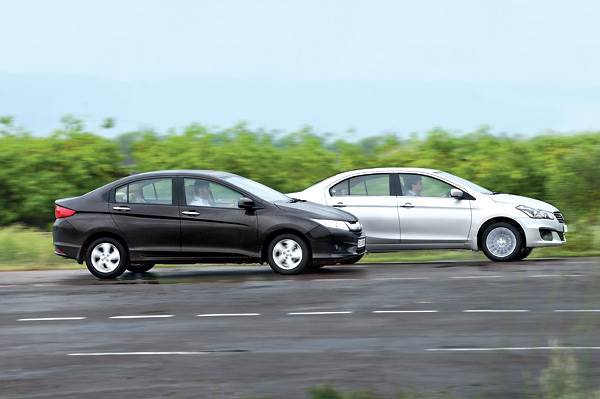
In sharp contrast is the City. Thanks to its arrow shot profile and bold creases on its sides, it looks exciting and sporty. The angular headlights are fantastic too, but that massive slab of chrome atop the grille is perhaps an overkill. A bigger issue, though, are those175/65 profile tyres that sit on 15-inch wheels.
Speaking of size, it’s the Ciaz that’s the larger car here. Just shy of 4.5 metres, it’s 50mm longer than the City in terms of both overall length and wheelbase. The benefit of the latter is clearly evident once we open the rear door.
Space vs comfort
It’s not been too long since the new City’s cabin blew us away for the sheer amount of legroom it had to offer in the rear. But where the City’s space is exceptional, the Ciaz’s is better still. There’s almost an excess of knee room in the back seat and also what feels like a wee bit more of shoulder room. As on the City, the light colours in the cabin just add to the feeling of space. Unfortunately, the extra space doesn’t automatically translate into the better rear seat experience. The Ciaz’s seat is firm, thigh support is just average and the sloping roof means headroom can be tight too.
Insufficient rear headroom is an issue for taller passengers in the City as well. But in terms of cushioning, seating posture or general support, the City’s rear seat has the Ciaz beat. Honda’s secret lies in the foam density of the seats which offers sofa-like levels of comfort. Hence, if you are purely talking seat comfort, owners will find themselves a lot happier in the City.

Both cars do get dedicated rear air-con vents, rear charging points and foldable centre armrests (the Ciaz’s is better positioned) but neither get adjustable rear headrests or, for that matter, dedicated headrests for middle occupants.
It’s when we move up front that the Ciaz does make a far stronger case for itself. Sure, some parts such as the steering wheel and power window switches are common to lesser Marutis, but overall quality is pretty impressive and helps give the Ciaz’s interior a rich look. Metallic highlights and smart wood accents also embellish the cabin in just the right amount. And while not radical in layout, the uncluttered dashboard is well thought out. The easy-to-operate seven-inch touchscreen on the centre console for the audio, Bluetooth, telephone, rear-view camera and navigation functions further underscore the Ciaz’s user-friendliness. To find fault, we’d have to bring up the front seats which are a touch too high and though the driver’s perch does come with height adjust, taller folk behind the wheel might not be able to find the ideal driving position.

Where the Ciaz falters, the City scores. Its front seats are just about perfect, and provide a great view out, high dashboard notwithstanding. The thing is, the dashboard itself is a love-it or hate-it affair. It’s got an unusual asymmetry to it and perhaps too many varied design elements. The five-inch touchscreen (not as nice as the Ciaz’s), for instance, seems lost in the glossy black centre console. And while unique, the touchscreen to operate the climate control settings is an unnecessary distraction while driving. Overall quality is also a mixed bag. While the chunky steering is great to hold, the hard plastics on the dash face are not very premium.
Both cars score very well in terms of practicality. They offer lots of space for storing knick knacks within their cabins and big suitcases in their large boots. And as mentioned before, in fully-loaded form, the duo are also quite similar in terms of features. Both get leather seats, climate control, rear air-con vents, steering-mounted audio and telephone buttons, touchscreens, keyless go, rear-view cameras (though the City does without sensors) and dual airbags. Where the City VX also gets you a sunroof, the Ciaz comes with on-board satellite navigation.
Pace vs grace
The diesel engines on both cars have got their fair share of attention on these pages, so we won’t go into the details. To give you a brief, the Ciaz’s Fiat-sourced 1.3 engine makes 89bhp that is down on the larger Honda 1.5’s 98.6bhp. Interestingly, peak torque is an identical 20.4kgm. The Ciaz’s engine specs may seem underwhelming on paper but in the real world, performance is not bad. It’s not a particularly sprightly engine but it’s not weak either. Maruti has tuned the engine well to minimise its inherent lack of grunt at low revs and within average city driving, you won’t have much to complain about. The smooth-shifting five-speed gearbox with well chosen ratios and a nicely-weighted clutch help here. That said, it’s advisable to keep revs above 1800rpm, which is where the turbo gets into the flow of things and delivers good punch right till the 5300rpm limiter.
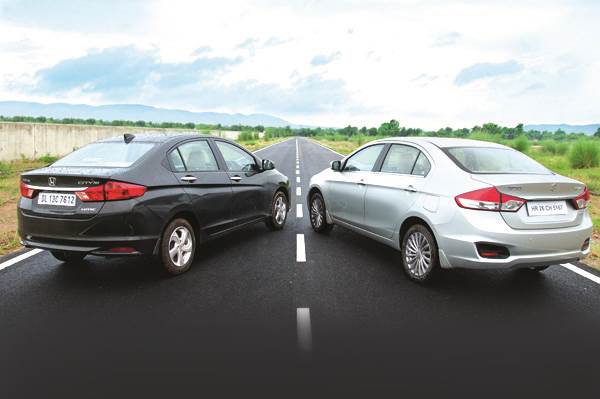
The Honda motor doesn’t rev quite as high (it tops off at 4250rpm) or have the same spike in delivery, but it is the more responsive unit. Power comes in well below 2000rpm and that makes life easier in the urban grind. However, building up to higher speeds, we did find ourselves using the slick six-speed gearbox more than anticipated. The narrower powerband (there’s little power after 3000rpm) is to blame here. At 100kph in fifth gear where the Ciaz’s engine will spin at 2300rpm, the City’s also feels a lot busier, though revs will be just 100rpm more. However, the City’s sixth gear does help reduce noise levels and improve cruising ability with revs at a more reasonable 2000rpm at 100kph.
While we are yet to measure the Ciaz for performance at our standard test location, preliminary figures suggest it’s the quicker car at least in terms of 0 to 100kph time – the Ciaz’s 12.99 seconds is considerably faster than the City’s 14.75 seconds. Through the gears, though, the two cars are near identical. But where the two cars are very different is when speaking engine refinement. The City’s engine sounds coarse and almost industrial at all points of time, more so after a ride in the quiet Ciaz. Maruti has done a really good job with sound deadening.
Ride vs handling
It’s not engine noise alone that Maruti has managed to keep out. Even the Ciaz’s suspension goes about its business remarkably quietly. All manner of bumps are dealt with a nice suppleness that only furthers the relaxed ambience in the cabin. Out on the highway, the Ciaz feels planted, secure and free from much vertical movement. It drives like a larger, much heavier car and that’s a compliment. On the same stretch of highway, the City will pitch a wee bit more than the Ciaz but, still, never to the point of hurting comfort. The City’s straight-line stability is good too though the suspension doesn’t fend off sharper bumps quite as successfully (or quietly) as the Ciaz’s.
But if it’s the Ciaz’s ride that gets our vote, it’s also the City’s handling that we vouch for. The Honda has the nicer steering with good weight and reasonable feel. It’s also sportier in the manner it dives into corners more readily. And before you think otherwise, grip levels from the slim MRFs are surprisingly good. The Ciaz’s steering, though well weighted, feels numb and unexciting. Handling, on the whole, is safe but don’t expect it to keep up with the City on a twisty course.
Indecision
The Ciaz promised to give the City a close fight, and a close fight is what we got. Leaving the subjective section of looks aside, where the Maruti’s cabin scored for space and ambience, the City’s scored for comfort. Then, where the Ciaz’s engine scored for refinement, the City’s scored for ease of use. And finally, where the Ciaz scored for ride quality, the City scored for driving pleasure. But to say one’s strengths are the other’s weaknesses would be incorrect. It’s just that in areas where the Ciaz is better, the difference to the City is small. But in areas where the City is better, it’s significantly better than the Ciaz.
However, things do tip in the Ciaz's favour when you factor in prices. The top-spec Ciaz for now, the ZDi (O), costs Rs 9.8 lakh (ex-showroom, Delhi) and gets you plenty of kit. We expect the touchscreen-equipped Ciaz ZDi+ that will go on sale in early 2015 to cost about Rs 10.1 lakh.
That would make the Ciaz a full Rs 1 lakh cheaper than the top Honda City VX diesel. Sure, the City does get cruise control and a sunroof as well, but the price difference still seems rather big.
So, in the final analysis, the Honda City may be the better car but the Maruti Ciaz is the better package.
Nikhil Bhatia
More on the Maruti Ciaz
Maruti Ciaz photo gallery
Maruti Ciaz review, test drive
Maruti Ciaz vs rivals: price and spec comparison
Maruti CIaz vis rivals: features comparison

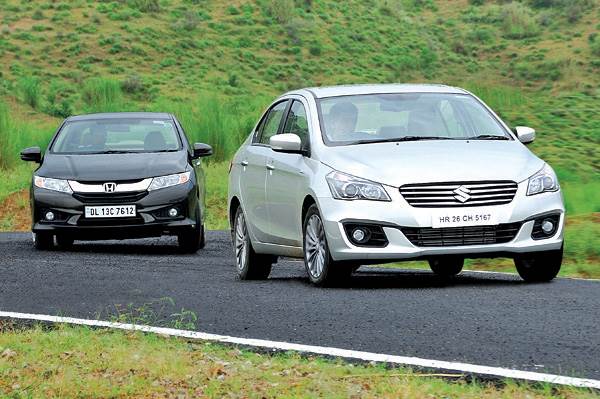
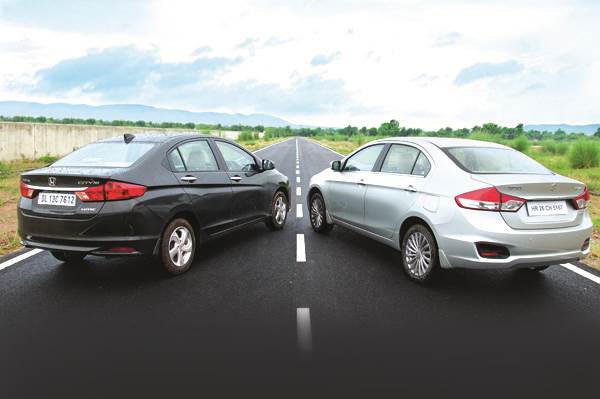
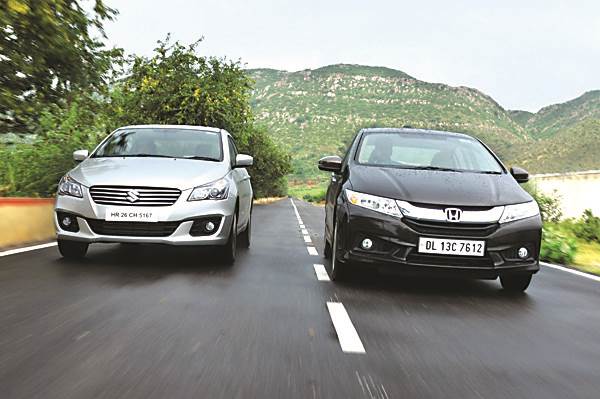
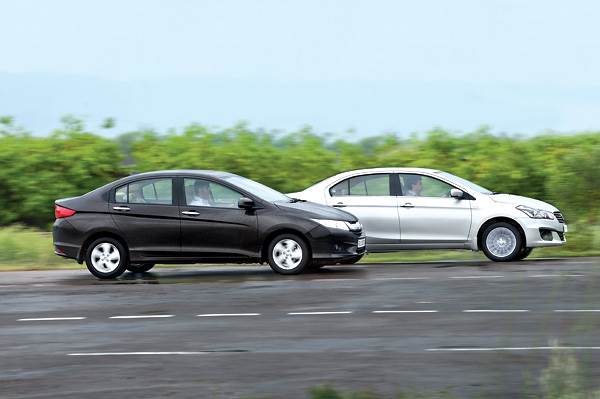


Comments
Member Login
Personal Details
No comments yet. Be the first to comment.